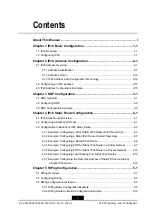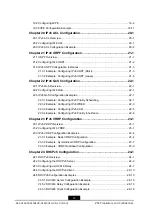
ZXR10 ZSR V2 Configuration Guide (IPv6)
Steps
1.
Configure ICMPv6.
If a router cannot process an IP packet due to some reasons (no route can be found
or the packet contains a wrong layer 3 protocol number), an ICMP error packet is
generated possibly and sent back to the source node of the IP packet. The source
node corrects the reported error.
Step
Command
Function
1
ZXR10(config)#
interface
<
interface-name
>
Enters interface configuration
mode.
2
ZXR10(config-if-interface-name)#
ipv6 forward
unreachable
After this command is
configured, the forwarding
plane forwards a packet of
an unknown protocol or a
packet whose route cannot
be found to the control plane.
The control plane returns an
ICMP destination unreachable
packet to the source node.
By default, this function is
disabled (the original packet
triggering the generation of
an ICMPv6 error packet is
discarded on the forwarding
plane).
3
ZXR10(config)#
icmp-config
Enters ICMP configuration
mode.
4
ZXR10(config-icmp)#
interface
{
byname
<
interface-byname
>|<
interface-name
>}
Enters ICMP interface
configuration mode.
5
ZXR10(config-icmp-if-interface-name)#
ip
unreachable
Enables a specified interface
to send ICMPv6 destination
unreachable packets. By
default, this function is
enabled.
<
interface-byname
>: interface alias, containing up to 32 characters.
<
interface-name
>: interface name, containing 1 through 32 characters.
2.
Configure TCPv6.
TCPv6 is based on IPv6. TCPv6 has the same functions as TCPv4, so this manual
does not cover those functions again.
1-2
SJ-20140504150128-018|2014-05-10 (R1.0)
ZTE Proprietary and Confidential





























